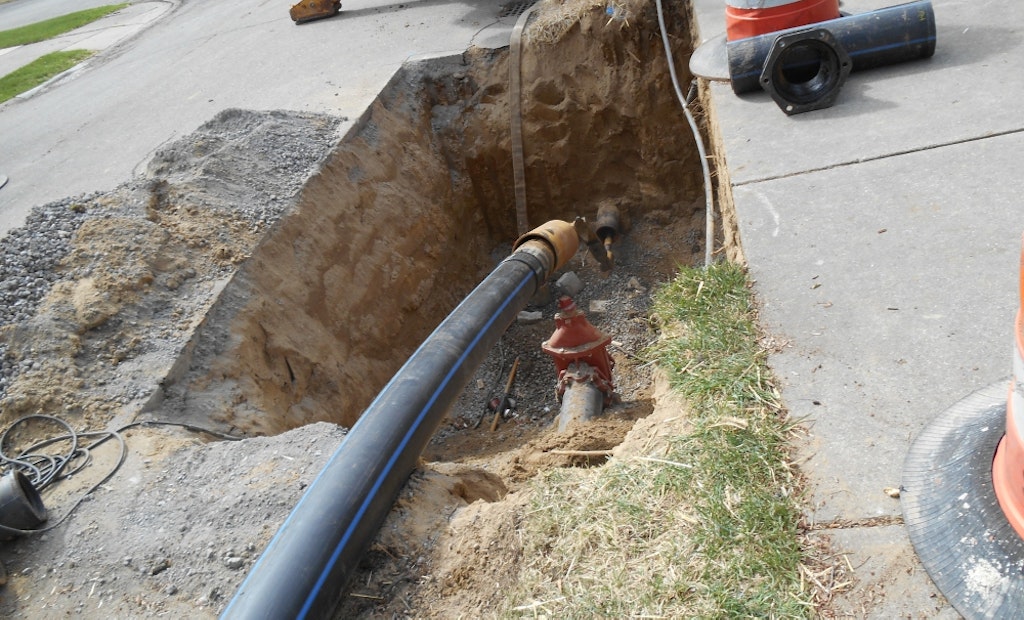
Interested in Municipal/Industrial?
Get Municipal/Industrial articles, news and videos right in your inbox! Sign up now.
Municipal/Industrial + Get AlertsTake Bloomfield Village, Michigan, as a prime example of why it pays to get involved in the pipe bursting business. When the village had aging water mains to replace, and prepared to put the work out for bid, it specified prechlorinated pipe bursting.
That’s because the 1,000-home section of Bloomfield Township has gracefully winding, tree-lined residential streets branching off into carefully landscaped lanes and cul-de-sacs, all maintained under guidance from the village’s homeowners association. Generations of residents have worked hard to maintain the serenity and pleasing aesthetics of the village since its establishment in 1924.
Olivia Olsztyn-Budry, Bloomfield Township engineer, says almost from the beginning plans for the four-year water service upgrade specified prechlorinated pipe bursting. It spared Bloomfield villagers from the property disfigurement and detouring traditionally associated with opencut water main renovation.
Other underground trenchless replacement methods were considered, such as horizontal drilling, but the pipe bursting technique was most conducive to the limited space available along the street right-of-ways in the village. With no rig to position as in the horizontal drilling technique, and working to and from comparatively small access pits, pipe bursting presented the least amount of disruption to traffic. Nor was residents’ water service interrupted except for the single day that work was performed in front of their homes.
Pipe bursting specialist
Pipe bursting specialist Bidigare Contractors of Northville, Michigan, was the low bidder for the multiphase project, expanding its workforce in a joint venture with D’Angelo Bros Utilities of Farmington Hills, Michigan.
For bursting operations Bidigare used its own hydraulic pipe bursting machine, a HammerHead Hydroburst HB100. Although the machine is capable of up to 100 tons of pulling force, John Bidigare, vice president of Bidigare Contractors, says the average burst required is only about 20 tons.
Bidigare Contractors began replacing the 17,000 feet of Phase I pipe in October 2013, completing the first 3,000 feet as scheduled before shutting down for winter that November. Work resumed in March 2014, and Bidigare is on track to complete the entire project this year.
Replacement specifications
The Bloomfield Village water system enhancement project launched with three primary objectives: replace aging and undersized water mains, replace and upgrade fire hydrants and improve coverage, and replace and add water system valves for more reliable water system operation. It was designed to take place in four phases, giving highest priority to sections that were most urgent. Phase triage considered three factors: age of pipe involved, water main breakage record, and potential conflicts with utilities.
Portions of Bloomfield Village’s legacy water system range in age from 47 to 90 years old. The newest sections of the 11 miles of ductile iron pipe, valves and hydrants were installed in 1968.
Most bursting in the Phase I stage of the project involved 8-on-8 replacement of ductile iron pipe with high-density polyethylene, with some sections of 6-inch ductile iron to be upgraded to 8-inch HDPE.
Prechlorinated pipe replacement
Originally a method devised in Europe, the prechlorinated pipe bursting technique was first introduced to the U.S. for a Florida municipal water main replacement in 2000. Seventeen years later the technique is commonly used throughout both the U.S. and Canada.
In his presentation to Bloomfield Village’s water main board, Bidigare explained in detail how prechlorinated pipe bursting would be conducted, property by property.
The process begins on the surface by fusing sticks of HDPE to the length required to complete a burst. The fused pipe is pressure tested, chlorinated and tested for bacteria by a state-certified lab. Then it is sealed at both ends, one with an 8-inch DIPS pulling head fused onto it and the other with a fused cap.
The prechlorination process can take up to two days. Once sealed, the sterilized pipe can remain this way for up to two weeks prior to use in the replacement process, which allows for staging pipe in advance of a series of bursts.
Installation process
Prior to each burst, Bloomfield Village utilities were located and flagged. Residents received 24 hours’ notification of when they would lose water service, which usually lasted eight to 12 hours. For many residents, the shut-off occurred at the time of day when they were away from home, minimizing disruption to their daily routines.
Each evening prior to the next day’s bursting operations, the crew prepared two 5- by 10-foot access pits, 5 to 6 feet deep. One would serve as a working pit with the pulling machine in it, and the other as the replacement pipe entry pit, where the bursting run would begin.
During a typical 10- to 12-hour shift that included a pipe bursting run, the burst itself generally took between two and three hours to perform.
Pull rod was paid out from the HB100 through the existing pipe to the entry pit. A flex joint connected the pull rod to a pulling head nestled inside a hollow body expander. The expander’s function is to fracture the existing pipe and press it away from the pipe path, leaving sufficient room for the pulling head and replacement pipe.
Expanders are typically 25 percent larger than a pipe’s nominal diameter. For the 8-inch HDPE in this application, the expander was 10 inches in diameter. The replacement pipe, which was fused directly to the pulling head, was drawn along behind the pulling head as the assembly progressed.
Once in place, crews flushed the pipe, reattached the residential service to the main and activated the water system. Other than the access pits, the only other landscape affected was a 3- by 3-foot pit to access the water service shut-off valve. Though pipes were believed to be sterile, residents were advised by the city to boil drinking water during the next day or two, until receiving confirmation by a certified laboratory that their water did indeed pass regulatory guidelines.





